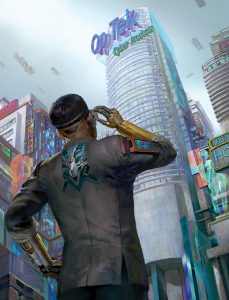Trinity Continuum: Anima is, at least partially, a cyberpunk game. And cyberpunk is best when it’s using near-future settings to say something about our modern world. Here’s a bit about the state of the Anima world in 2084.

State of the World in 2084
The prosperity of the Nova Age depressed fertility rates around the globe, dramatically slowing global population growth — especially on the newly ascendant African continent. Millions swarmed through portal networks to off-world colonies at the height of the Nova Era, lured by the promise of living among the stars, while millions more remain still in transit in vast colony ships, their telemetry lost to monitoring stations. After the Earth Strike Ultimatum, the departing Aberrants took still millions more with them, swallowing entire cities with yawning portals.
Some left willingly to places warmed by distant suns — if their will could truly be said to be their own while in thrall to a nova’s incredible charisma and intelligence. Most went unwillingly, enslaved for prospective star emperors or taken as raw fuel matter for bioreactors powering Aberrant colonies. Even twenty years hence, the populace lives in mortal fear of Aberrant attacks, with hunters still tracking and killing people once hailed as humanity’s saviors. Every nation funds Aberrant hunter offices as official branches of law enforcement, given broad jurisdictional powers and elite training. They’re seen as grimly necessary, for while a handful of discovered novas flee the planet each decade to chase their brethren to the stars, others — particularly those without the capability to travel into space — fight back.
All told, the end of the Nova Age saw nearly a billion fewer people living on the planet than when it began. The survivors — everyone left behind — feel a burgeoning commonality of purpose. The world takes halting, hesitant steps back toward globalization, while many countries have strong internal pressure to retreat into self-isolation. Everyone tends to themselves and their families first, rebuilding their communities and worrying about the world later. Those who do look outward find kindred spirits in every nation, eager to build a new world free of the prejudices and problems of the old, emboldened by medical technologies to change sex and appearance in virtually any way. To the eyes and hearts and OpNet newsletters of the young, the horrors of the Aberrant War were necessary mistakes for a new and better world to be born.
Technology
The horrors of the Crash have mostly faded. Hyperfusion power plants are back online, providing cheap power and enabling nations to focus on rebuilding rather than basic needs. Smart household items that anticipate purchasing habits, organs cloned from adult stem cells, powered armor assisting soldiers, and holographic AI assistants have all come into vogue after falling out of fashion after the Possession Crisis. Project ReWrite is in full swing, reintroducing “clean” versions of nova-tech, purged of their former brand names and painful histories. The countries funding the Project — and the Æon Covenant — have their hands in several research tanks secretly dedicated to reverse-engineering nova-tech. Last but far from least, Glass allows for projection into the OpNet, in an experience deeper and cleaner than any previous neural interface.
Humanity lives in a world in dire need of rebuilding, a fact that most citizens of every nation desperately try to ignore. Corporate leaders cling to capitalism like a lifeline, and while the radical global changes during the Nova Age have checked their worse impulses, those checks stretch further and further into the past. Automation has put many out of work, and while manual labor to help rebuild is necessary in some areas, heavy lifting robots take up most of the grunt work. Most of humanity tries to find meaning in careers both pointless and mandatory. Even the people of Cascade, foremost among the world in the propaganda story of rebuilding the Earth, do not look forward to the future or backward to the past, but inwards to their second lives on the OpNet.
Everyday life in this era is still recognizable from the early years of the Nova Age. People live in homes in rural areas, or apartments in cities, with few in the suburbs in-between; they study, they work, they go out. All vehicles drive themselves, freeing passengers in transit to sleep or eat while automatically adjusting for traffic patterns and optimal speeds. Many of the more expensive ones even fly, remnants of the flying cars of the Nova Age. Homes are cheaper than they’ve ever been; entire family lines were extinguished by the Aberrant War, freeing up a tremendous amount of real estate. Getting a new house is as simple as ordering one from the OpNet. Once granted the requisite permits from township authorities, automated flying trucks mounted with industrial 3D printers create the new home in a matter of hours, seamlessly integrating it with the surrounding environment and connecting the domicile to hyperfusion lines. It takes a mere day to wire the new home into the OpNet. The rich and famous maintain their cultural hegemony through vanity items and conspicuous consumption — artificially inflated costs for fancier fabrication patterns and premium colors. Even so, students and the poor make do with renting an apartment in the cities, many of which bear the scars of the War.
Superhydrophobic coatings and materials allow the wealthy to wear designer suits printed with boutique designs that literally can’t get wet, and license to recreate those clothes with a high texture count when projecting onto the OpNet. Neural electrodes have replaced the bulky neural helms of previous years, though these provide an indescribably lesser experience than using Glass to project into the OpNet.
Physical and Mental Health
Almost everyone has access to advanced scanners and self-monitors that regulate the body to help alleviate basic health issues caused by bad habits and stress, although the connectivity to the OpNet means security of medical data is a top priority for many hospitals and healthcare providers. Glass leads the curve in this and many other fields, transforming the way the human mind works and granting transparency into the inner workings of the self. Birth ailments continue to plague the population of every nation, ranging from genetic damage and scarred burns caused in utero by quantum detonations to deformations caused by genetic bioweapons meant to eugenically cleanse the world. Even cancer has returned, with the first cases of exotic cancers being seen in young adults since the 2030s. Despite these numerous setbacks, gene therapies remain widely available, and life expectancy is climbing toward three digits once again. All the while, the first children born since the War are now coming of age, embracing the OpNet more enthusiastically than any generation prior.
Mental health is a critical focus of health care. The profound devastation of the planet and of society has caused new and unseen levels of post-traumatic stress disorders, and skilled therapists find themselves in high demand. Many have taken to holding meetings over the OpNet, where a single therapist can run a group therapy session for dozens of people simultaneously. Several companies have put forth artificial therapy intelligences, but most users consider the art of designing artificial intelligence to be a pale shadow of the industry during the Nova Age. Newer AIs simply lack some intrinsic sense of empathy, limiting their use as a therapy tool beyond reinforcing and aiding in the control of triggers. With Glass, however, an AI is capable of surprising insight into a person’s physiological triggers for mental issues, either directly ceasing those triggers with the Glass node or deploying sophisticated scripts to precisely talk the patient through their mental issues.
Most people play games as an escape. Entertainment is more present than ever, keeping the teeming masses of humanity too occupied to dread the world they live in. Dozens of OpNet studios stream their own extravagant productions, often hosting them alongside servers allowing neural interface users to star in their own replicated productions and alter the plot, though many serious gamers deride the low content quality of “game of the movie” servers. The two most popular pastimes are reliving the glory days of the past in historical reenactment servers or playing in MMOs such as Terra Surge, giving people a healthy dose of community engagement and personal escapism at the same time.
Sporting events are also popular, although digital e-sports have overtaken the national pastimes of many countries. For many, “watching the game” means booting up their neural electrodes and reenacting a historic FPS match or watching synchronized skydivers plummet from a simulated orbit. Many famous locations have licensed their locations in the OpNet, allowing users to visit the world, sample foreign cuisine, and see wondrous and ancient landmarks before the Aberrant War for a fraction of the cost of physically traveling and without all the hassle. Locals can also sell their services as virtual tour guides, projecting into the OpNet to show a stranger a locale through foreign eyes. With the advent of Glass, the most successful tour guides have created mnemonic intelligences, entire chains of hometown memories that can be downloaded to make a person feel like a true native — until the license expires for the municipal familiarization, at which time the sensation of being at home erases itself.
